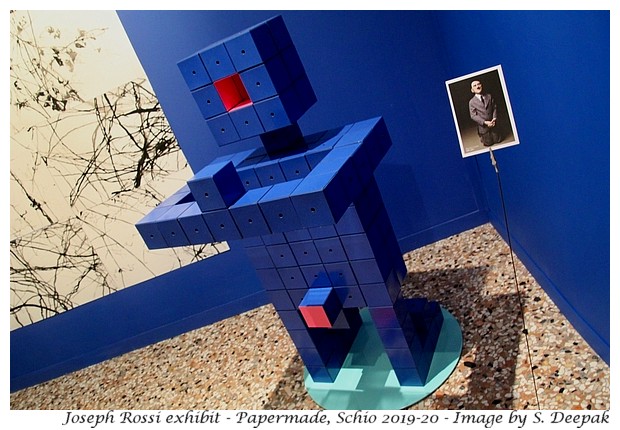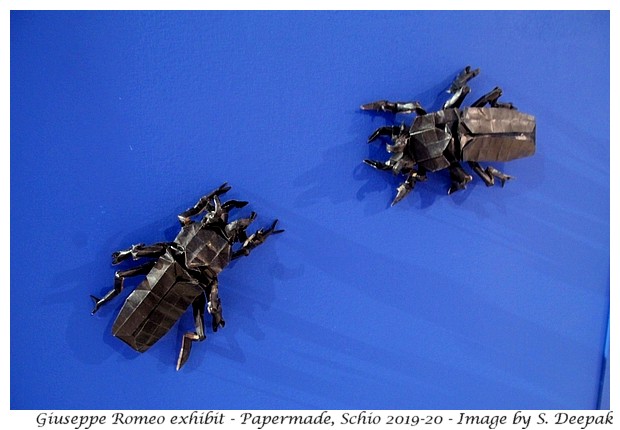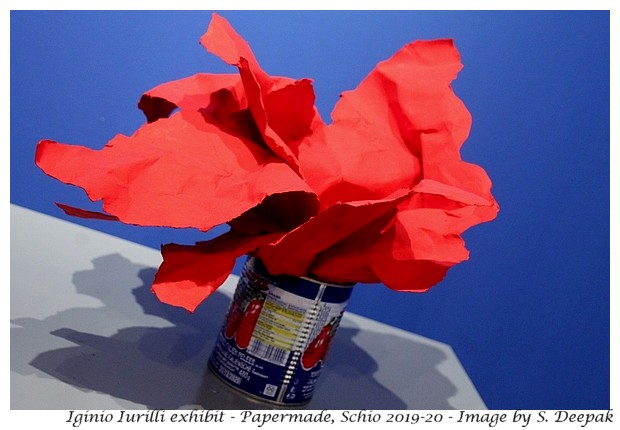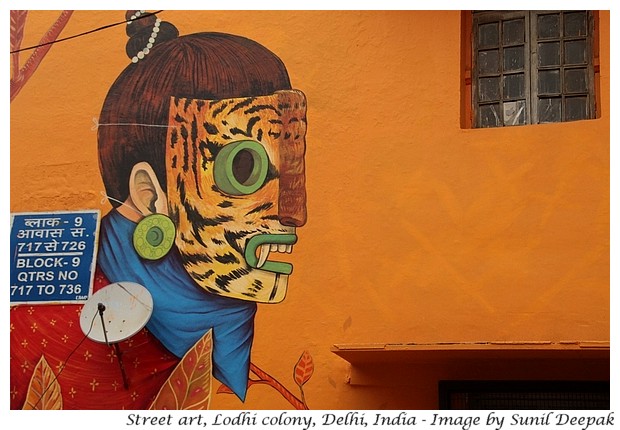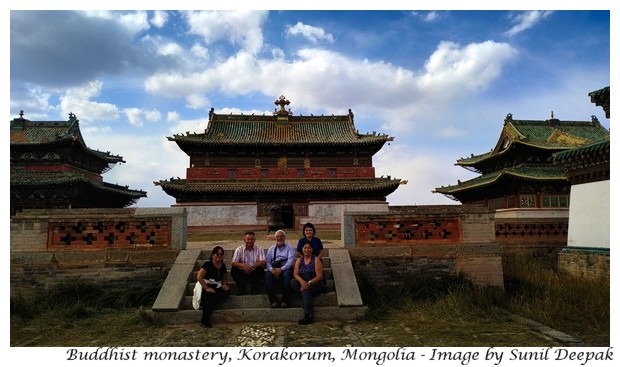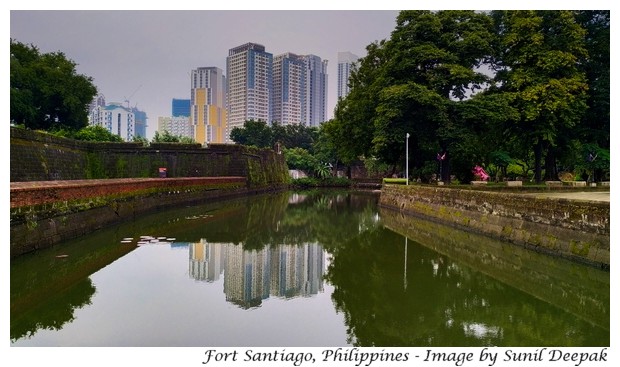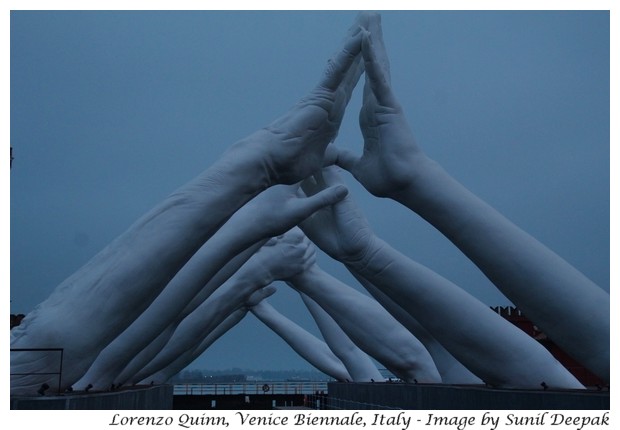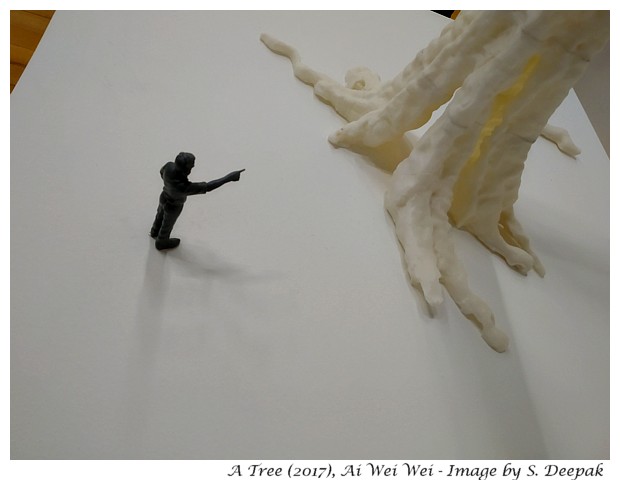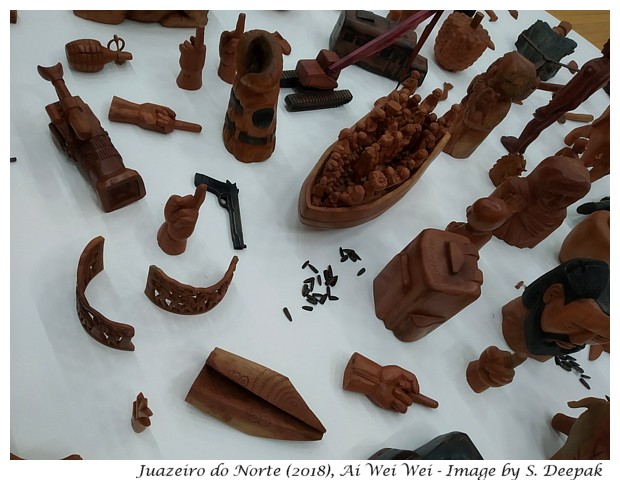This post is about my favourite 15 art works from the 2019-20 Papermade exhibition.
The Theme of Papermade 2019-20
The theme of 4th edition of Papermade curated by Valeria Bertesina is "Beauty in the non-essential". Art and beauty may be seen as unnecessary, even superfluous, but I feel that art and beauty add life to our lives. Prehistoric humans understood it, when they made cave art, necklaces out of colourful beads and painted figures on earthenware.This exhibition started in October 2019 and will finish on 9 February 2020 (Note: it has been extended till 13 April 2020). It includes two special events - (1) a series of "sculptures" by Joseph Rossi which re-interpret some iconic & provocative works of the well-known Italian artist Maurizio Cattelan, and (2) a mini- exhibition of 15 artists from Finland. The image above presents "Him" by Joseph Rossi, which was a re-interpretation of the Maurizio Cattelan sculpture (2001) of a school boy with the face of Hitler kneeling in prayer.
Re-Interpreting Maurizio Cattelan
Joseph Rossi is a graphic artist based in the nearby Thiene. This edition of Papermade is hosting few of his installations, including some which are a homage to the iconic works of Maurizio Cattelan.Cattelan, a famous artist based in Padova (Padua), has been in the news recently because of his provocative work of "art" which had a banana fixed to the wall with a duct-tape in the "Art Basel" exhibition in Miami Beach USA, which was sold to an unnamed French art collector for 120,000 dollars and eaten by the Georgian performance artist David Datuna. I think that such works are an example of performance art, which may even be seen as a criticism of the way "conceptual art" is dominating the various recent biennales.
The image above presents another of Joseph Rossi's re-interpretation of Cattelan's provocative works - of the 1999 wax sculpture called "Ninth Hour" which showed Pope John Paul II lying dead crushed by a meteorite.
Finnish Artists in Papermade
There are works of 15 well-known artists from Finland in this Papermade exhibition. They range from art-works with pastel and ink on different kinds of paper, to etching, mezzotint and digital prints. They also include 2 installations - (1) Trio Schio, a paper-meche work by Arja Jappinen; and (2) Beauty, an assemblage including cut paper and origami by Jouni Boucht (in the image below).Among all the other Finnish artists, my favourite were the 'charcoal on paper' art works by Paula Suominen, presented in the image below.
Another work which I liked very much was called "Land of the Free", made with ink and spray paint by Egs, a well-known graffiti artist from Finland. The image below shows part of this work.
Other Art-works at Papermade
An important presence at Papermade was of the Australian artist Giuseppe Romeo. His cockroach-like origami "sculptures" with a metallic finish, greeted visitors on the stairs and spread over the exhibition, on the floors and the walls, looking like an infestation.I liked the colours and vivacity of the collages by the Italian artist Elsa Pietrelli.
I was touched by the digital print of a woman's face by the Vietnamese artist Quang Pham Khac, who explained that it was an image of his wife, which he has been making in different forms over the recent period to cope up with her death.
I loved the colours and feelings evoked by the series of paintings/collages by Silvio Cattani inspired by the poetry of the famous Russian poet Sergej Yesenin.
The tropical foliage (below) and the human figures created by Canadian artist Zachari Logan in his "Eunuch Tapestrieses", with pastel art-work on black paper, were visually very striking because of their vivid colours and details.
I am not a fan of the "conceptual art". Even in this exhibition, there were a couple of such installations, which I felt were unexciting and a kind of lazy art. However, I liked the idea behind Iginio Iurilli's simple installation called "Exploding tomato sauce can" (below).
I liked the prints from etchings/woodcut/Relief by Tribhuvan Kumar Dev from India, Haladaj Wieslaw from Poland, Linda Whitney from USA (presented in the image below), Marco Trentin & Leonardo Marenghi from Italy and Yuji Hiratsuka from Japan.
Finally, I liked the tiny and exquisite water-colours of birds by Michela Moretto (below).
For this post I have presented pictures of 15 art-works which I had liked. However, I am very much aware of my own fickle subjectivity - on another day, I would have chosen other art-works. If I ask you to choose your favourite art-works from this exhibition, surely your choice would be different from these 15 works!
Conclusions
I think that this edition of Papermade has a lot to see, admire and think. Generally speaking, in an exhibition on paper art, I would like to see works which use paper in innovative ways and not just as a background to make prints or to paint with ink, pastels or water-colours. In that sense, there were not many new ideas in the exhibition. However, if you visit it with an expectation of seeing art which stimulates you and makes you reflect, you won't be disappointed.Let me conclude this post with two cut-paper origami inspired works - the delicate "Between you and I" by Susanna Doccioli (above), and the gossamer "Suspended Labyrinth" by Susy Manzo (below).
The exhibition is open till 9 February 2020 (Note: it has been extended till 13 April 2020), so if you are visiting Schio, do not miss it. It is a 5 minutes walk from the railway station.
*****

